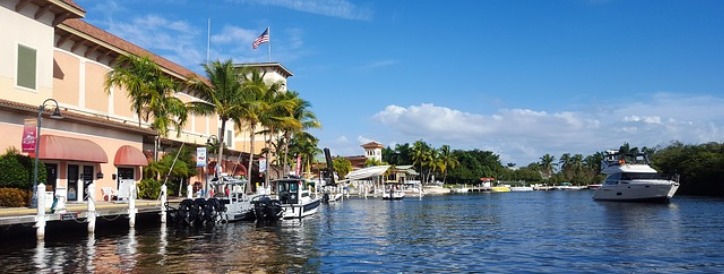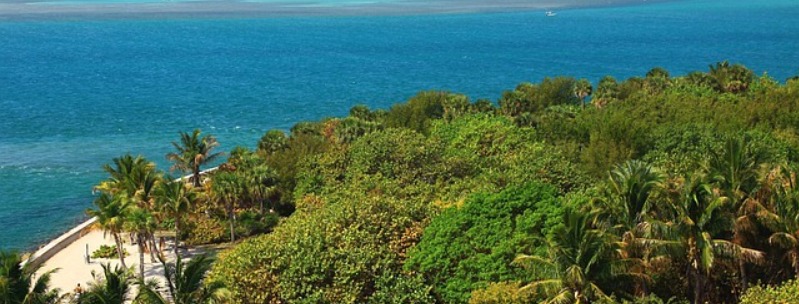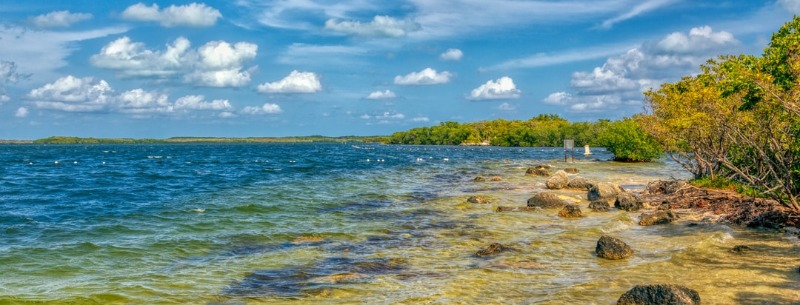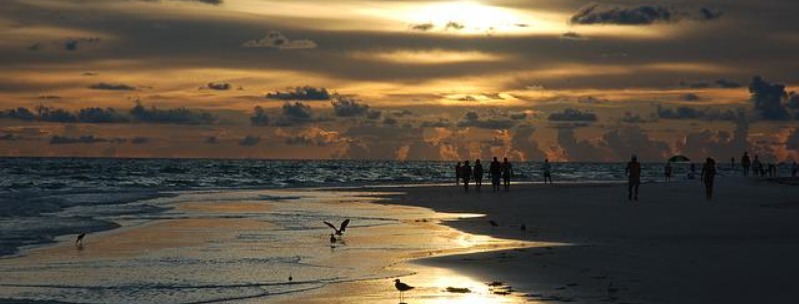What Florida Keys have the best beaches?
The Florida Keys are famous for their tropical atmosphere, which is enveloped by turquoise water and long stretches of coral reefs. The Atlantic will be on ones left as you drive south through the 125-mile-long chain of islands, while the Gulf of Mexico will be on your right. You’ll pass by many beautiful beaches all along way, but you’ll want to stop at these ones.
Best beaches in Key West
Much closer to Cuba than to mainland Florida, Key West often seems rather tenuously bound to the rest of the US.
Famed for their tolerant attitudes and laid-back lifestyles, the thirty thousand islanders seem adrift in a great expanse of sea and sky, and – despite a million tourists a year – the place resonates with an individual spirit that hits you the instant you arrive.
As wild as it may at first appear, Key West today is far from being the hippy hangout of a decade ago. Much of the sleaziness has been brushed away through a steady process of restoration, setting the course for the advent of a sizable holiday industry.

Even so, the sense of isolation from the mainland is best appreciated by adjusting to the mellow pace: amble the gorgeous, lushly vegetated streets, make meals last for hours, and pause regularly for refreshment in the numerous bars.
Fort Zachary Taylor Historic State Park is a Historic Landmark with some of the clearest blue waters in Key West for diving and snorkeling. Its southern end is home to the Key West’s favorite beach, making it ideal for those activities as well as paddling, fishing, and picnicking.
Smathers Beach on Key West is a popular Keys destination for families. It extends for more than two miles and offers plenty of white sand for a variety of activities such as a morning jog or relaxing with a stunning view. In addition, there are numerous restaurants nearby where you can take a break from the Florida sun while satisfying your appetite.
As you travel south from Smathers, Higgs Beach is south of the White Street Fishing Pier and adjacent to the Waldorf Astoria’s Casa Marina Resort. This urban beach has a grove of palm trees for shade, a number of picnic tables, a dog park, and free parking.
Key Biscayne Beaches
A compact, immaculately manicured community, Key Biscayne, five miles off mainland Miami, is a great place to live – if you can afford it.
The only way onto Key Biscayne is along the four-mile Rickenbacker Causeway, a continuation of SW 26th Road just south of downtown, which soars high above Biscayne Bay, giving a gasp-inducing view of the Brickell Avenue skyline.
Crandon Park Beach, a mile along Crandon Boulevard (the continuation of the main road from the causeway), is one of the finest landscaped beaches in the city, with crystal-clear waters, barbecue grills and sports facilities.

Three miles of yellow-brown beach fringe the park, and give access to a sand bar enabling knee-depth wading far from shore.
Crandon Boulevard terminates at the entrance to the Bill Baggs Cape Florida State Recreation Area, four hundred wooded acres covering the southern extremity of Key Biscayne.
An excellent swimming beach lines the Atlantic-facing side of the park, and a boardwalk cuts around the wind-bitten sand dunes toward the 1820s Cape Florida lighthouse.
Key Largo Beaches
The first and largest of the keys, Key Largo boasts a fine opportunity to visit the Florida Reef, at the John Pennekamp Coral Reef State Park at MM102.5.
This protected 78-square-mile section of living coral reef is rated as one of the most beautiful in the world.

If you can, take the snorkeling tour, or the guided scuba dive; the glass-bottom boat tour is less demanding.
Cannon Beach is located at John Pennekamp Coral Reef State Park in Key Largo. It was named after the 17th-century cannons that lie along its rocky shore, and it is one of the island’s two man-made beaches. Most visitors come to snorkel rather than sunbathe or create sandcastles. It’s one of the top locations in the continental United States to snorkel, and it’s home to the nation’s first undersea park, which encompasses the water west of Key Largo and the beach.
Even from the glass-bottom boat, you’re virtually certain to spot lobsters, angelfish, eels and jellyfish along the reef, and shoals of silvery minnows stalked by angry-faced barracuda.
The reef itself is a delicate living thing, comprising millions of minute coral polyps extracting calcium from the seawater and growing from one to sixteen feet every thousand years.
Sadly, it’s far easier to spot signs of death than life: white patches show where a carelessly dropped anchor, or diver’s hand, has scraped away the protective mucous layer and left the coral susceptible to terminal disease.
Best beaches in the Middle Keys
Once over Long Key Bridge, you’re into the Middle Keys . At the not-for-profit Dolphin Research Center , on Grassy Key at MM59 (daily 9am-4pm; $15; tel 305/289-0002), you can swim with the dolphins for $135 (reservations must be made at least one month in advance).
Long Key State Park is yet another Florida Keys paradise, with a long beachfront that provides tropical fantasy-like views, as well as opportunities for kayaking, swimming, hiking scenic trails, picnic areas, and abundant wildlife. Or simply sit on the beach and gaze out at the azure Atlantic. Bird enthusiasts will be in heaven with a wide variety of bird species such as ibis, herons, terns, and egrets.
The largest of several islands, Key Vaca holds the nucleus of the area’s major settlement, Marathon. Here you’ll find a couple of small beaches – rare in the Keys – and great fishing and waters ports.
Sombrero Beach, along Sombrero Beach Road, has good swimming waters and shaded picnic tables; Key Colony Beach four miles north is prettier and quieter.
Nestled inside the 64-acre tropical forest of Crane Point Hammock, the Museum of Natural History of the Florida Keys provides an excellent introduction to the history and ecology of the area at MM50.5.
Marathon has several well-equipped resorts, such as the lush, luxurious Banana Bay, MM49.5, and indulgent Cheeca Lodge & Spa, MM82. Sombrero Beach is near Marathon’s Mile Marker 50 if you’re looking for an empty stretch of sand. Because of its remote location at the end of Sombrero Beach Road, it is frequently silent during the off-season and very seldom overcrowded during peak season.
For eating, Herbie’s, MM50.5 is justly busy on account of its inexpensive seafood, chowder and fritters.
The tiny, laid-back Seven-Mile Grill, by the bridge of the same name, serves delicious conch and creamy Key Lime Pie to locals, sea salts and tourists.
The Quay, MM54, has good fish sandwiches for $5 in a waterfront tiki bar behind the pricey main restaurant, and Porky’s , MM47.5, offers cheap, traditional barbecue dishes and burgers, along with conch fritters and other local seafood specialties. Take a free sunset cruise whether you eat there or not.
Best beaches in the Lower Keys
Starkly different from their northerly neighbors, the Lower Keys are quiet, heavily wooded and predominantly residential.
Built on a limestone rather than a coral base, these islands have a flora and fauna all their own. It feels very quiet as you head south: everyone’s gone fishing or is snoozing in a hammock.
The first place of consequence you’ll hit after crossing Seven Mile Bridge is Bahia Honda State Park at MM37, one of the Keys’ prettiest spots.
Its lagoon has a beckoning natural beach and pristine, two-tone ocean waters, which can be enjoyed on a leisurely kayak ride.
Divers should head for the Looe Key Marine Sanctuary, signposted from the Overseas Highway on Ramrod Key – a five-square-mile protected reef area, easily the equal of the John Pennekamp Coral Reef State Park.
Of the nearby motels, Looe Key Reef Resort, MM27.5, is a favorite with divers, an ideal base for visiting the marine sanctuary.
There are also a couple of luxurious, secluded B&Bs; along Long Beach Drive, off the Overseas Highway; you’ll need to book ahead.
Exceptionally friendly, even for the Keys, Mangrove Mama’s, MM20 on Sugarloaf Key, serves stupendous local cuisine in a cheery shack with a tropical garden.
